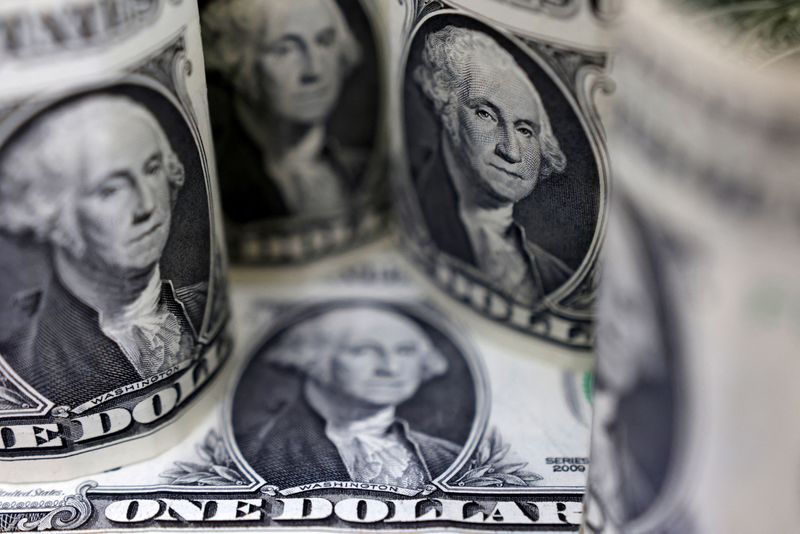Forex
US dollar rises on global growth worries; Aussie down


© Reuters. U.S. Dollar banknotes are seen in this illustration taken July 17, 2022. REUTERS/Dado Ruvic/Illustration/file photo
By Saqib Iqbal Ahmed
NEW YORK (Reuters) -The dollar rose to a near six-month high against a basket of currencies on Tuesday as jitters over global growth, particularly in China, caused investors to flock to the safe-haven U.S. currency.
The dollar slumped after the Reserve Bank of Australia kept rates steady.
China’s services activity expanded at the slowest pace in eight months in August, a private-sector survey showed on Tuesday, as weak demand continued to dog the world’s second-largest economy and stimulus failed to meaningfully revive consumption.
The decline in euro zone business activity accelerated faster than initially thought last month as the bloc’s dominant services industry fell into contraction, according to a survey which suggests the bloc could drop into recession.
“Worries are on the rise about a China and Europe-led slowdown in global growth. As a result the dollar is catching a solid safe haven bid,” said Joe Manimbo, senior market analyst at Convera in Washington.
“At the same time elevated inflation in the U.S. is leading to fading expectations for the Fed to cut rates any time soon,” he said.
Federal Reserve Governor Christopher Waller said on Tuesday the latest round of economic data was giving the U.S. central bank space to see if it needs to raise interest rates again, while noting that he currently sees nothing that would force a move toward boosting the cost of short-term borrowing again.
Financial markets believe the Fed’s rate hikes are over. But Waller cautioned against making such an assumption, noting that the Fed has been burned before by data that appeared to show an improvement on the inflation front only to see price pressures come in stronger than expected.
The – which measures the currency against six major counterparts – was up 0.62% at 104.8. The index hit a near 6-month high of 104.85 earlier in the session.
“From here we could potentially make a run at its 2023 highs if we continue to see weakness abroad,” Convera’s Manimbo said.
The euro was down 0.69% after hitting a near 3-month low against the dollar at $1.07225.
The U.S. dollar also climbed against China’s currency, and was last up 0.36% at 7.3035 against the yuan traded offshore.
The China-exposed Australian dollar was one of the weakest currencies against the greenback, down 1.29% at a fresh 10-month low, after Australia’s central bank on Tuesday kept interest rates steady for a third month, encouraging speculation the tightening cycle was over as policymakers indicated they have a firmer grip on prices.
“It’s kind of a one-two punch against the Aussie. On the one hand you had a status quo decision by the RBA and on the other you had the worrisome news out of China,” Convera’s Manimbo said.
The dollar climbed to a 10-month high of 147.8 yen as traders watched for any signs the Japanese government was ready to intervene to prop up their currency, as it did last year.
A deteriorating global growth picture sent the pound to a 12-week low against the dollar after a survey showed business activity in Britain contracted last month. The pound was last down 0.5% at $1.2565.
In cryptocurrencies, bitcoin slipped 0.29% to $25,743, hovering near a 12-week low.

 Forex3 years ago
Forex3 years agoForex Today: the dollar is gaining strength amid gloomy sentiment at the start of the Fed’s week

 Forex3 years ago
Forex3 years agoUnbiased review of Pocket Option broker

 Forex3 years ago
Forex3 years agoDollar to pound sterling exchange rate today: Pound plummeted to its lowest since 1985

 Forex3 years ago
Forex3 years agoHow is the Australian dollar doing today?

 Cryptocurrency3 years ago
Cryptocurrency3 years agoWhat happened in the crypto market – current events today

 World3 years ago
World3 years agoWhy are modern video games an art form?

 Commodities3 years ago
Commodities3 years agoCopper continues to fall in price on expectations of lower demand in China

 Economy3 years ago
Economy3 years agoCrude oil tankers double in price due to EU anti-Russian sanctions





















